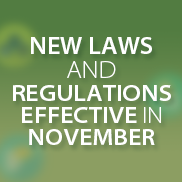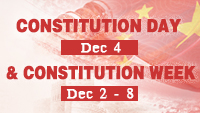Annual Report on Promoting the Rule of Law in China(2016)
VII. Promoting Progress in Ecological Environment Management
(1) Legislation for Ecological Civilization
——Issuing a batch of guiding documents. The Leading Group of the Central Committee of the Communist Party for Comprehensively Deepening the Reform adopted the Opinions on the Compensation Mechanism for Improving the Ecological Protection, the Guiding Opinions on the Establishment of the Green Financial System, the Measures for the Evaluation and Assessment of Targets for the Construction of Ecological Civilization, Some Opinions on Delimiting and Strictly Holding to the Red Line for Ecological Protection and the Measures for the Registration for the Uniform Confirmation of the Right to Natural Resources. The Ministry of Environmental Protection distributed the Guiding Opinions on Giving Positive Play to the Role of Environmental Protection to Promote the Supply-side Structural Reform in April. It required the provincial environmental protection departments to strengthen supervision over environments to promote the elimination of outdated producing capacity and slash excessive capacity. The State Development and Reform Commission and the Ministry of Environmental Protection issued the Opinions on Fostering Market Subjects for Environmental Control and Ecological Protection in September. It accelerated the fostering of market subjects for environmental control and ecological protection to promote the supply-side structural reform for environmental protection.
——Formulating, revising and annulling a batch of laws, local regulations and rules. The Nineteenth Session of the Standing Committee of the Twelfth National People’s Congress adopted the Law on the Exploration and Development of Deep Seabed Resources in February. It made the norms for Chinese citizens, legal persons and other organizations to carry out activities of exploration and development of the resources in deep seabed areas. The Ministry of Environmental Protection issued the Measures for the Supervision and Management of the Safe Transportation of Radioactive Goods in March. The Twenty-first session of the Standing Committee of the Twelfth National People’s Congress adopted the Decision on Revising Six Laws including the Energy Conservation Law of the People’s Republic of China in July. The Ministry of Environmental Protection issued the Decision on the Annulment of Part of the Rules and Normative Documents of the Environmental Protection Departments in July, and annulled ten departmental rules and 12l normative documents. The ministry issued the Measures for the Management of Records for Environmental Impact Registration Forms for Construction Projects in November.
Moreover, local governments also formulated and revised a batch of local regulations. For example, the Hupei Provincial Regulations on the Prevention and Control of Soil Pollution is China’s first local statue concerning the prevention and control of soil pollution. Shanghai revised the Municipal Regulations on Environmental Protection, the Xinjiang Uighur Autonomous Region revised the Environmental Protection Regulations of the Xinjiang Uighur Autonomous Region, Tianjin City issued the Tianjin Municipal Regulations on the Prevention and Control of Water Pollution, and Jilin Province issued the Jilin Provincial Regulations on the Prevention and Control of Air Pollution.
——Concluding and participating international environmental treaties. The Twentieth Session of the Standing Committee of the Twelfth National People’s Congress ratified the Minamata Convention on Mercury in April. The Twenty-first Session of the Standing Committee of the Twelfth National People’s Congress ratified the newly added Hexabromocyclododecane Amendment to the Stockholm Convention on Persistent Organic Pollutants in July. China formally became a party to the Nagoya Protocol on Access to Genetic Resources and the Fair and Equitable Sharing of Benefits Arising from their Utilization to the Convention on Biological Diversity in September. This signified the entry of the Chinese biological industry in the time of sharing benefits and the oversight on the genetic resources under the rule of law. A Chinese government delegation attended the Twenty-eighth Conference of the States Party to the Montreal Protocol on Substances that Deplete the Ozone Layer, and played a positive role in reaching agreement to the amendment on controlled greenhouse gas of HFCs.
——Issuing a batch of technical norms for environmental resources. The Ministry of Environmental Protection published a total of 59 state norms for environmental protection in 2016. By the end of 2016, there were 1,732 effective norms for environmental protection. Moreover, the ministry also revised the Catalogue of Preferential Policies for Income Taxes from Special Equipment Enterprises for Environmental Protection, united with the Chinese Academy of Sciences in compiling and publishing the fourth list of invasive alien species of the Chinese natural ecologic system, united with the State Development and Reform Commission and the Ministry of Public Security in publishing the National Roster of Hazardous Wastes (2016 edition), and distributed the General Programme for Technical Guide to the Assessment of Ecological and Environmental Damages, and made experiments on the reform in Jilin and six other provinces and municipalities.
The Chinese Academy of Sciences and the Ministry of Environmental Protection published the 2016 Roster of Biological Species in China. The 2016 Roster collected 86,575 known species, including 35,905 species in the animal kingdom, 41,940 species in the plant kingdom, 469 species in the bacteria kingdom, 2,239 in the pigment kingdom, 3,488 species in the fungi kingdom, 1,729 species in Protozoa and 805 viruses.
(2) Law Enforcement for Ecological Civilization
——Formulating a number of plans for environmental resources. The Ministry of Environmental Protection issued the Regulations for the Management of the State Demonstration Zones for the Construction of Ecological Civilization and the Norms for the Construction of Demonstration Counties and Cities for State Ecological Civilization. It stressed that it is necessary to further standardize the work of establishing demonstration zones for the construction of national ecological civilization, and promote the scientific, standard and systematic work of planning, reporting, technical evaluation, assessment for acceptance, notice and supervision and management. The ministry adopted the plan for the implementation of the plan for the construction of ecological environmental monitoring network (2016-2020) in February. It made clear that it would complete the task of taking back the monitoring power of the 1,436 state-controlled environmental air quality monitoring stations. The State Council printed and distributed the Action Plan for the Prevention and Control of Soil Pollution in May, and put forward the general periodic targets for the prevention and control of soil pollution by 2020, 2030 and 2050. The State Development and Reform Commission and the State Tourism jointly distributed the National Plan for the Development of Ecological Tourism (2016-2025). The State Council distributed the Plan for the Protection of Ecological Environments under the Thirteenth Five-Year Plan in December. It put forward the target for the general improvement of the quality of ecological environment by 2020, and decided to reach the restricted and expected norms of completing three campaigns, seven main tasks and safeguard measures in five aspects for the prevention and control of air pollution, water pollution and soil pollution by 2020 to fulfill the target of the general improvement of the quality of ecological environment.
——Deepening the reform of environment-related systems. The General Office of the State Council distributed the Plan for the Implementation of the Licensing System for the Controlled Discharge of Pollutants in November. It made clear that by 2020, it will complete the work of verifying and issuing licenses for the discharge of pollutants for all fixed pollutant sources, and establish the licensing system for the control of pollutant discharge to exercise control of pollution discharge with “one certificate for each enterprise”. The Ministry of Environmental Protection distributed the Interim Provisions on the Licensing Management of Pollutant Discharge in December to standardize the procedures for application, examination, verification, issuing and management.
China started the reform of the supervision and regulation system for environments in 2015. It set up three new departments for the management of water, air and soil. The General Office of the Central Committee of the Communist Party of China and the General Office of State Council printed and distributed the Guiding Opinions on the Work of Experiments on the Reform of the Vertical Management System for Law Enforcement through Monitoring and Supervision by Environmental Protection Organs at and below the Provincial Level in September. It started the Reform of the Vertical Management System for Law Enforcement through Monitoring and Supervision by Environmental Protection Organs at and below the Provincial Level.
——Strengthening the Work of Disclosing Information on Environments. The State Oceanic Administration published the Bulletin on China’s Sea Level and the Bulletin on Ocean Disasters in China. The Bulletin on China’s Sea Level reveals that the general tendency of change in the sea level in China between 1980 and 2015 was the rise with fluctuation, and the annual rise averaged three millimeters, higher than the global average. The Bulletin on Ocean Disasters in China showed that as a whole, the ocean disasters in 2015 were slight. They caused a direct economic loss of 7.274 billion yuan and 30 deaths (including missing persons). The General Office of the State Council distributed the Main Points of the Work of Disclosing the Major Administrative Affairs in 2016 in April. It required the major regions and main cities to disclose more information on the air quality and more monitored information on the water quality of the sources of the concentrated drinking water. It required the major pollutant discharging units to disclose the names of their main pollutants, how they were discharged, the density and total quantity of the pollutants discharged, the excesses they discharged, and the construction and operation of their facilities for the prevention and control of pollutants.
The Ministry of Environmental Protection published the names of the major enterprises under supervision for seriously discharging pollutants in the first quarter of 2016 in May. A total of 75 enterprises in 19 provinces and autonomous regions were involved. The ministry and 31 other central departments distributed the Memorandum of Cooperation for Joint Punishment for Dishonest Producers and Sellers and their Relevant Employees in the Field of Environmental Protection in July, and published the information on the administrative punishment related to environments on the National Honesty Sharing Platform.
All provincial and prefectural environmental protection departments opened columns on the government gateway webs for the exposure of law violations in environments. The provincial environmental protection departments all disclosed their automatically monitored data from major state-owned enterprises on the government gateway webs. The Ministry of Environmental Protection published the list of major state-owned enterprises which exceeded the pollutant discharge quotas every three months.
——Environmental protection supervision. Central environmental supervision teams exercised supervision over environmental protection in Hebei Province, Inner Mongolia, Beijing, Shanghai, and Eighteen provinces, autonomous regions and municipalities. They accepted more than 33,000 reported cases in 2016, and filed 8,500 cases for punishment and fined more than 440 million yuan and held 6,454 persons accountable for responsibility. Twenty-one provinces, autonomous regions and municipalities issued provisional plans for supervision in environment protection, and more than 20 provinces, municipalities and autonomous regions established environmental protection supervision organs.
——Investigating and handling environmental law violations. The ministry investigated 647,000 projects built in violation of the law and discipline, and cleaned up and consolidated 618,000 of them. It found 2,641 small enterprises that caused serious pollution, and outlawed 2,465 of them. It handled 974 cases of successive punishments on a daily basis, 9,622 cases of sealing up and seizure, and 5,211 cases of restricted or suspended production, and transferred 3,968 cases of administrative detention and 1,963 criminal cases of suspected environmental pollution.
(3) Administration of Justice for Ecological Civilization
——Formulating a batch of judicial documents for environments and resources. The Supreme People’s Procuratorate published the Measures for the Implementation of the Experimental Work of the People's Procuratorate Concerning Public Interest Litigation in January. It made clear how a procuratorial organ brings a civil public interest case or an administrative public interest case. The Supreme People’s Court issued the Measures for the Implementation of the Experimental Work of the People’s Court on Hearing Public Interest Cases Filed by the People’s Procuratorate in February. It made clear how the people’s court hears a civil public interest case or administrative case filed by the people’s procuratorate. The Supreme People’s Court distributed the Opinions on Giving Full Play to the Role of Adjudicatory Function to Provide Judicial Service and Safeguard for Promoting the Construction of Ecological Civilization and Green Development in June. It made clear the guiding thought, overall requirement, hearing principle and case type, and stressed the use of modern environmental judicial conceptions as the guide to explore the establishment of special organs, innovate the trial system and mechanism, study special hearing rules, strengthen the study of theoretical actual evidence, establish specialized trial teams and deepen judicial transparency and international exchanges in accordance with the requirements of the specialization of trials, and constantly improve services to guarantee the ability and standard of promoting ecological civilization and green development. The Supreme People’s Procuratorate distributed the Opinions on Comprehensively Performing the Procuartorial Function to Provide Powerful Judicial Guarantee for the Construction of Healthy China in October. It prescribed special provisions on the punishment of crimes of destroying environmental resources and impairing ecological security. The Supreme People’s Court and the Supreme People’s Procuratorate jointly revised the Interpretation of the Supreme People’s Court and the Supreme People’s Procuratorate concerning Some Issues on the Application of the Law to Handling Environmental Pollution Criminal Cases in December. It further clarified the specific standards for the determination of the crime and sentencing for the offence of environmental pollution, and the specific standards for the determination of the offence and sentencing for the offence of disposing of imported solid wastes illegally, the offence of importing solid wastes without authorization and the offence of negligence in supervision over environments, and the specific application of the criminal policy of combining leniency with severity.
——Hearing environmental and resource cases. The courts throughout the country tried and closed 18, 900 criminal cases of environments and resources, 84,700 civil cases of environments and resources and 29,100 administrative cases of environments and resources in 2016. The procuratorial organs throughout the country prosecuted 29,173 persons for the offences of destroying environments and resources. The Supreme People’s Procuratorate carried out the activities of exercising supervision over filing special cases of destroying environments and resources, and suggested the transfer of 2,016 cases of committing suspected offences, and supervised the handling of 22 major cases committed by Zhang Baifeng and others for the offences of discharging waste acids stealthily. The Supreme People’s Procuratorate popularized the practices of Fujian, Guizhou, Jiangxi and Chongqing, and explored the ecological procuratorial model of “specialized legal supervision + restorative judicial practice + socialized comprehensive governance” to promote environment protection and ecological restoration. Since the newly revised Environmental Protection Law took effect on January 1, 2015, the courts accepted a total of 112 cases of environmental public interest cases of first instance and 54 cases of second instance, and closed 54 cases of first instance and ten cases of second instance. The court in Dezhou of Shandong Province tried and closed China’s first public interest litigation case of air pollution in the Beijing-Tianjin-Hebei region and their surrounding areas since the new Environmental Protection Law took effect, and sentenced the defendant to a compensation of more than 21.98 million yuan for the restoration of the quality of the air environment in July.
——Promoting the reform of environmental judiciary. By the end of 2016, the courts throughout the country had set up 559 tribunals, collegiate panels and circuit tribunals, 17 higher people’s courts set up special divisions for the trial of environmental and resources cases, and the courts in Fujian, Guizhou, Jiangsu, Yunnan and Chongqing established specialized systems of courts at three levels for the trial of environments and resources.
It promoted the trans-regional division of jurisdiction over environments and resources cases and the mode of hearing cases of environments and resources under the new divided jurisdiction. The courts in Guizhou, Jiangsu, Hubei, Guangdong, Hebei, Qinghai, Xinjiang, Beijing and Hainan exercised trans-regional concentrated jurisdiction over environments and resources civil cases of polluting environments and destroying ecology with the consequences of damages affecting other regions, environmental public interest cases and other types of environments and resources civil cases. It gradually promoted concentrated jurisdiction, special jurisdiction and upgraded jurisdiction over environments and resources cases in the major regions of Beijing-Tianjin-Hebei, the three-river source region of the Yangtze River, the Yellow River and the Lancang River, and the Yangtze River Basin to promote the sustained improvement of the quality of the environments in the major regions.
——Strengthening guidance by judicial policies for environment and resources. The Supreme People’s Court issued the second batch of ten administrative cases of environmental protection in March. It issued ten typical cases of civil disputes over the mining right in July. It issued the White Book Trial of Environments and Resources in China in the same month. It held a joint work meeting of the courts in Beijing, Tianjin and Hebei on the trial of environment and resource cases, and signed the Framework Agreement on Cooperation among the Courts in Beijing, Tianjin and Hebei in the Work of Trying Environment and Resource Cases in September. It issued the Opinions of the Supreme People’s Court on Supporting the Major Arrangements for Accelerating the Construction of the Ecological Civilization Pilot Zone in September.
——Strengthening the theoretical research on environmental justice. It established a theoretical research base for environments and resources, a research base for environmental damage appraisal and a practice base for the trial of environment and resource cases, and organized academic seminars on the topics of “environmental rights and interests and the enactment of the civil code”, “the judicial issues in the governance of environmental regions”, “the theory and practice of green justice” and “seminars on the judicial confirmation of environmental damages” to keep close interactions with the academic circles.
——Promoting International cooperation in environmental justice. The Supreme People’s Court organized the International Symposium on the Judicial Response to Climate Change, organized the Bilateral High-Level Environmental Justice Seminars with France and Brazil, and sent the Chinese delegation of judges to attend the First World Environment Law Congress held in Rio de Janeiro, Brazil to further enhance communication and exchanges between China and other countries of the world in environmental justice.



